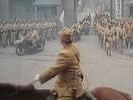Eye For Film >> Movies >> Black Sun The Nanking Massacre (1995) Film Review
In the late 1980s the Hong Kong administration changed its system of film classification, introducing a new, adults-only rating, Category III. While the rationale behind the Category III film was to allow for more challenging, serious fare than had hitherto been permitted by the territory's family-audience focussed filmmakers, in practice it was their exploitation filmmakers who were the main beneficiaries.
There were also some, however, who arguably managed to combine art and exploitation. T F Mou is a case in point. In 1987 he made Man Behind The Sun (Hak Taai Yeung 731), an expose of biological warfare experiments conducted by Unit 731 of the Japanese Army. While few would doubt that it was a history that needed to be told, the question was whether the horror/gore format was the appropriate telling – all the more so when its commercial success inaugurated a series of imitations and sequels, of which The Nanking Massacre – also known as Man Behind the Sun 4 – is at least the third.

Using a combination of reconstruction and archival footage, the film documents the “Rape of Nanking” wherein, over a period of a couple of months, the invading Japanese massacred an estimated 300,000 Chinese.
While skilfully put together, with an effective combination of broad-brushstoke detail and individual incidents and characters held together by the linking figure of one man just trying to survive it all and get back to his children, The Nanking Massacre suffers from the simple fact that the archival material is far, far more powerful and disturbing than the reconstructions, some of which – a soldier bayoneting a pregnant woman, then lifting foetus out on the point of his blade – have the unfortunate sense of being more about splatter FX than anything else.
Put another way, it's a mixing of forms that doesn't work, the documentary footage serving to undermine the reconstructions and the reconstructions cheapening the documentary footage, most notably in the climactic montage where the effective juxtaposition of one group of Japanese soldiers relaxing and singing Silent Night as another machine guns yet another group of Chinese is almost neutralised by the inclusion of real documentary executions, slowed down for extra effect. Likewise, the frequent use of melodramatic music, while understandable in terms of convention and emotional cueing for the spectator, seems a touch overdone by implying that the diegetic content isn't strong enough by itself.
Then again even if the film had been comprised solely of reconstructions, the same problem, that of representing the unrepresentable, might well have still emerged. For, as one of the titles at the end admits starkly, “the atrocities were even worse than that shown in this film”.
To Mou's credit he successfully places the massacres in some sort of context and avoids depicting the Japanese as inhuman monsters, instead showing us something of their ideology and the conflicts among their number, most notably in the telling exchanges between Takayuma, a samurai-styled figure in traditional garb, and army commander Kyogo, as mere samurai wannabe.
Indeed, as with the more familiar films about Nazi atrocities – and here we should note the presence of the German John Rabe, using his Swastika armband as “evil fighting evil” as another instance of the film's nuances – is the very way in which otherwise normal people can be made to think and act by their supposedly wiser and more intelligent leaders that is perhaps the most terrifying thing about The Nanking Massacre.
Reviewed on: 10 Nov 2006




















